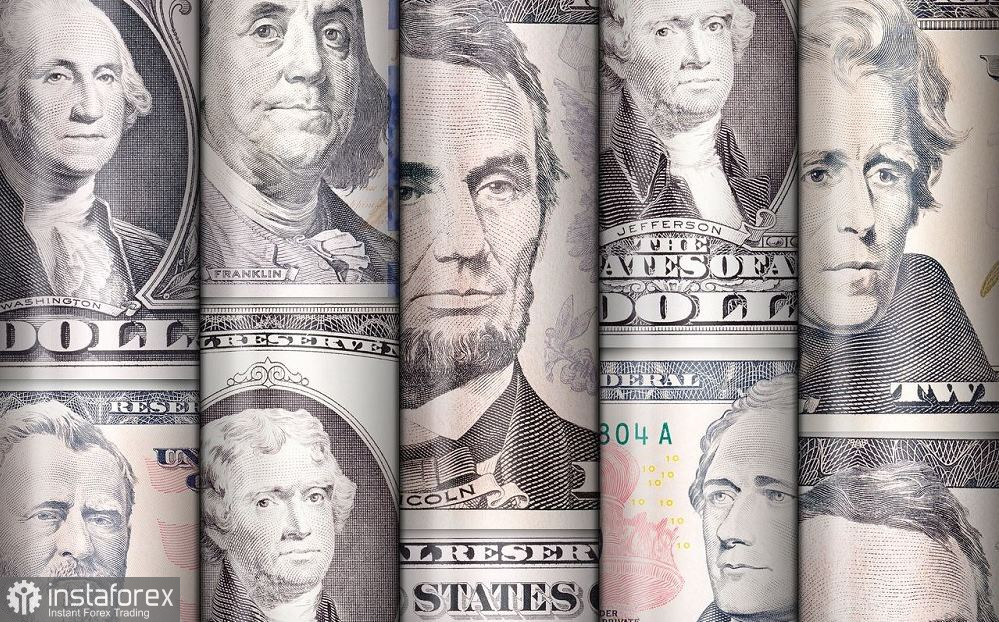The EUR/USD pair ended the trading week at 1.0904. Friday's non-farms report failed to reverse the uptrend, although the report did strengthen the dollar's positions in almost all pairs of the "major group". The US Dollar Index, reacting to the report, hit a 3-day high, but retreated toward the end of the trading day due to profit taking ahead of the weekend.
Overall, the trading week closed in favor of the EUR/USD bulls: the opening price was 1.0841, while the closing price was 1.0904. If we look at the weekly chart, we can see that the pair has been demonstrating a clear uptrend since the end of February/early March. After 6 weeks, traders came close to the psychologically important price barrier of 1.1000, the importance of which can be compared with the significance of parity.
The dollar is in a slump
The previous week has shown an interesting trend: the dollar reacts negatively to weak macro data (which is logical), but at the same time it essentially ignores positive signals. For instance, the pair managed to gain almost 200 pips (going from 1.0790 to 1.0974) because of disappointing ISM manufacturing and service sectors data in the US. While a fairly decent report on the US labor market, with almost all of its components coming out in the green zone, was blatantly ignored by the bears. A formal 50-point decline followed by an upward pullback is a questionable "achievement" for the bears.

All of this suggests that the greenback is in a slump. The aftermath of the banking crisis continues to haunt the dollar. Market participants are monitoring how the Federal Reserve uses their funds and are tracking the outflow of bank deposits. Concerns about the banking industry are gradually subsiding, but it is still too early to say that we have finally reached a definitive end to the crisis. The Fed raised the interest rate by 25 points in March, but also made it clear that further steps in this direction are highly questionable. The Fed's median forecast suggests another hike before the end of the year, but this is more of an optional possibility rather than a directive. Every negative macro report reduces the chances of this "option," especially since US inflation has consistently declined. But even a stronger hawkish sentiment in the market doesn't help the dollar, as this would represent the final chord, the last 25-point rate hike in the current cycle of monetary tightening.
Useless non-farms for the dollar
Traders' reaction to Friday's nonfarm says a lot. According to preliminary forecasts, the unemployment rate in the US was expected to show negative dynamics again (rising to 3.7%). The employment growth figure could have been disappointing as well, given the earlier report from ADP, which came out much worse than expected. But in fact both components of the official report came out in the green. Unemployment fell to 3.5% and employment rose to 236,000 (vs. the forecast of +225,000). Only the inflation indicator was disappointing: the average hourly wage rose 4.2% (with a forecasted decline to 4.4%). This is the weakest growth rate of the indicator since August 2021.
As of Friday, the odds of a 25-point rate hike at the Fed's May meeting rose to 71% (according to the latest CME FedWatch Tool). A week ago, the chances of rates remaining unchanged in May were estimated at 60-70%. In other words, the market is now almost certain that the Fed will decide on another round of rate hikes. But at the same time, the dollar has actually remained in the same position, weakly reacting to growing hawkish expectations.
In my opinion, the reason is quite trivial: the infamous 25-point rate hike has already been priced in, so the market reacts strongly only when the probability of this scenario decreases. While any confirmation of it does not provoke strong volatility.
Conclusions
The current fundamental picture suggests that the pair has not exhausted its growth potential. The dollar is vulnerable, while the euro enjoys support from the European Central Bank, whose representatives do not rule out a 50-point rate hike at the next meeting. Unlike the US, core inflation continues to rise in the eurozone, forcing the ECB to take countermeasures.
From a technical perspective, EUR/USD could not even reach the nearest support level at 1.0870 (the Tenkan-sen line on the daily chart), the breakthrough of which is a minimal condition for building a bearish correction. As a result, the price returned to its previous positions, in the area of the 0.9 figure. The pair is still between the middle and the upper lines of the Bollinger Bands indicator on the 1D chart, as well as above all lines of the Ichimoku indicator (including the Kumo cloud). All of this suggests being bullish. The nearest target for the upward movement is 1.1000, which corresponds to the upper line of the Bollinger Bands indicator on the same chart. It is too early to speak about the prospects of conquering the 1.10 level, since much will depend on the dynamics of US inflation, and the March value will be announced on April 14.
 English
English 
 Русский
Русский Bahasa Indonesia
Bahasa Indonesia Bahasa Malay
Bahasa Malay ไทย
ไทย Español
Español Deutsch
Deutsch Български
Български Français
Français Tiếng Việt
Tiếng Việt 中文
中文 বাংলা
বাংলা हिन्दी
हिन्दी Čeština
Čeština Українська
Українська Română
Română

